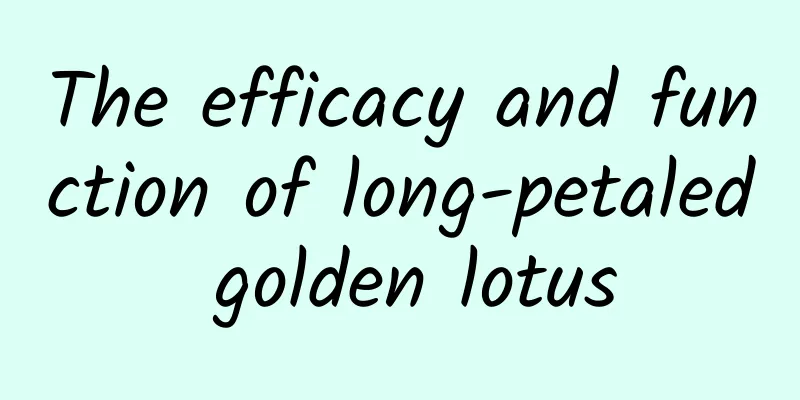The efficacy and function of long-petaled golden lotus

|
Long-petaled Nasturtium is a medicinal material frequently used in traditional Chinese medicine and is often used to treat various diseases. So today I would like to share with you some information about Long-petaled Nasturtium. [Source] Medicinal material source: The flower of the long-petaled nasturtium of the Ranunculaceae family. [Original form] Long-petaled nasturtium, perennial herb. The whole plant is hairless. The stem is 70-100cm tall, with sparse 3-4 leaves. There are 2-4 basal leaves with long petioles; the leaf blade is pentagonal, 5.5-9.2cm long, 11-16cm wide, cordate at the base, 3-parted, the lobes are separate, the central lobe is rhombic, 3-lobed to the middle, the margins are densely covered with slightly unequal triangular sharp serrations, the lateral lobes are obliquely fan-shaped, 2 deeply lobed near the base, the upper deep lobe is similar to the middle lobe, the lower deep lobe is smaller and obliquely rhombic. Flowers are solitary at the terminal end or in sparse aggregate inflorescences of 2-3; flower diameter 3.5-4.5cm; sepals 5-7, golden yellow, turning orange-yellow when dry, broadly ovate or obovate, rounded at the apex, with inconspicuous small teeth, 1.5-2.5cm long; petals 14-22, longer than sepals, sometimes nearly as long as sepals, narrowly linear, gradually narrow at the apex, often sharp, 1.8-2.6cm long, about 1mm wide; stamens 1-2cm long, anthers 3.5-5mm long; carpels 20-40. Lettuce fruit, about 1.3cm long, 4mm wide, with a beak length of 3.5-4mm. The seeds are narrowly obovoid, about 1.5 mm long, black, with 47 ridges. The flowering period is from July to September, and the fruiting period begins in July. [Habitat distribution] Ecological environment: Growing in wet grasslands between 450-600m above sea level. [Properties] Characteristic identification: the flowers are wrinkled, moist and flattened, with a diameter of 2.5-4.2cm; sepals are 5-7, orange-yellow, broadly ovate or obovate, 1.5-2.3cm long, 1.2-1.5cm wide, rounded at the tip, with inconspicuous small teeth; petals are 14-22, brown, narrowly linear, 2-3cm long, with sharp tips; stamens are numerous; ovaries are aggregated with 20-30, styles are short-pointed, and brown inside. It has a slight fragrance and a bitter taste. [Chemical composition] Long-petal nasturtium contains vitexin, orientin, veratric acid and globeflowery acid. 【Nature and flavor】 Bitter; cold 【Meridian】 Lung meridian 【Functions and indications】 Clears away heat and detoxifies. Mainly upper respiratory tract infection; acute and chronic tonsillitis; acute conjunctivitis; acute otitis media; acute lymphadenitis; acute dysentery; acute appendicitis [Usage and Dosage] For oral use: decocted in water, 3-6g. 【Excerpt】 Chinese Materia Medica The above is the relevant knowledge about the long-petal nasturtium introduced to you. Through the above article, you can clearly understand that the long-petal nasturtium has many benefits and functions for the human body, so you can use the long-petal nasturtium to treat some diseases. |
<<: The efficacy and function of Dishe
>>: The efficacy and function of long-stalked plantain fern
Recommend
The efficacy and function of winged stem bee grass
Only when we understand the main ingredients of a...
The efficacy and function of the root bark of Myrica pubescens
Do you know what the root bark of Myrica pubescen...
Ephedra Root Side Effects
Ephedra root has significant effects in treating ...
What is the difference between Pueraria lobata and Pueraria lobata
There are countless plants in nature, and the val...
The efficacy and function of the bark of the hairy wood
The bark of the hairy wood tree is a common Chine...
What are the effects of traditional Chinese medicine epimedium
Few people know that Epimedium has a high medicin...
What are the effects of Bletilla striata powder
Most people may not know what Bletilla striata po...
What are the benefits of drinking wolfberry and jujube soaked in water?
More and more people are beginning to pay attenti...
Come and see! These blood-sucking bugs are scarier than mosquitoes and carry a variety of pathogens...
There is a kind of insect that can suck blood fro...
The efficacy and function of pollen dregs
Since Chinese medicine has fewer side effects, mo...
Don’t be afraid if you have fatty liver! Learn these few tips to get the fat out of your liver
Current status of fatty liver disease in my count...
What are the benefits of eating milk and eggs together? After reading the fourth point, I silently picked up the milk and eggs.
Milk and eggs are both animal foods, and the effe...
Eel head effects and functions
Eel head has a long history, and until now, the u...
What are the medicinal values of stone flower?
Agate is a very common Chinese medicinal material...

![The efficacy and function of ginger[picture]](/upload/images/67ca0e94a02a9.webp)







